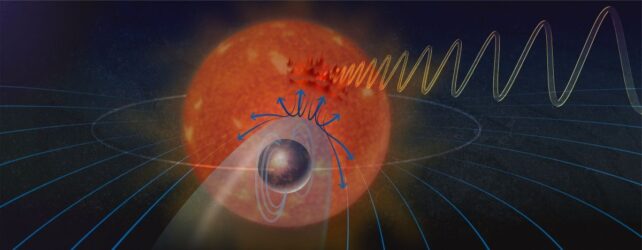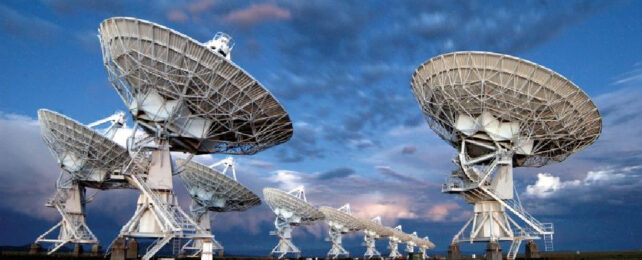Astronomers have traced a repeating radio signal back to a rocky, Earth-sized exoplanet that appears to have one of the crucial factors that make a world habitable: a magnetic field.
The planet is known as YZ Ceti b, and it's orbiting a small red dwarf star located around 12 light-years from Earth.
"The search for potentially habitable or life-bearing worlds in other solar systems depends in part on being able to determine if rocky, Earth-like exoplanets actually have magnetic fields," said Joe Pesce, the program director of the US National Science Foundation's National Radio Astronomy Observatory, which supported the work.
"This research shows not only that this particular rocky exoplanet likely has a magnetic field but provides a promising method to find more."
A magnetic field is what stops a planet's atmosphere from being stripped away by powerful stellar winds.
Mars, for example, used to have an atmosphere and was a warm and wet planet before it lost its magnetic field and, without its protection, its atmosphere was gradually eroded away by plasma from our Sun.
Jupiter, Saturn, Uranus, and Neptune still have magnetic fields in our Solar System. And in the past, astronomers have found evidence of larger exoplanets with their own magnetic fields.
But up until now we've not been able to identify magnetic fields on smaller, rocky worlds outside our Solar System. In fact, we've not even had a reliable way to even look for them.
It turns out, the repeating radio signal may be the clue we need. The team believes it's being caused by the planet's magnetic field interacting with YZ Ceti, the star it orbits.

(National Science Foundation/Alice Kitterman)
Before you get too excited, it's unlikely that YZ Ceti b is teeming with life as we know it, even if it does have a magnetic field. The rocky exoplanet is situated so close to YZ Ceti that its orbit is just two days (for comparison: our Sun's closest planet, Mercury, takes 88 days to complete a full orbit).
But if the planet's magnetic field is confirmed with further observations, it means we'll finally have a way to detect more life-friendly worlds like it in future, which is incredibly exciting in the search for habitable planets.
The signal was picked up by the Karl G. Jansky Very Large Array in New Mexico and identified when astronomer Jackie Villadsen from Bucknell University in Pennsylvania was looking over the data at home on a weekend.
"I'm seeing this thing that no one has seen happen before," Villadsen told Jason Stoughton in a press release for the National Science Foundation.
"We saw the initial burst and it looked beautiful," added astronomer Sebastian Pineda, the other researcher on the paper, from the University of Colorado, Boulder.
"When we saw it again, it was very indicative that, OK, maybe we really have something here."
So what's causing the signal? The current hypothesis is that the powerful radio waves are being generated as the planet's magnetic field barges through the plasma spewed out by its star.
For this reason, YZ Ceti b – with its very short orbit – is a prime candidate to pick up a magnetic field, interacting with its star more frequently and violently to generate radio waves strong enough to be detectable all the way from Earth.
"We're looking for planets that are really close to their stars and are a similar size to Earth. These planets are way too close to their stars to be somewhere you could live, but because they are so close the planet is kind of plowing through a bunch of stuff coming off the star," said Villadsen.
"If the planet has a magnetic field and it plows through enough star stuff, it will cause the star to emit bright radio waves."
This is essentially what the team saw: across five observing periods, Villadsen and Pineda found powerful radio signals blasted out by YZ Ceti, almost in sync with the orbital period of YZ Ceti b, which indicates that it's the interaction between the planet and the star creating them.
Based on the strength of the radio waves, the team were able to show that they could be explained by the planet having a magnetic field. If confirmed, it would be the first rocky, Earth-sized exoplanet shown to have one.
But even though the evidence so far is compelling, there's still not enough to rule out that something else is causing the stellar radio waves.
There's also the fact that the radio waves were "nearly" (but not perfectly) lined up with the planet's orbital period to consider.
This could be caused by a tilt in the planet's magnetic field, the team explain in their paper, similar to the tilt in Jupiter's magnetic field. But further observations are needed before we know for sure what we're seeing.
"It's going to be a lot of follow-up work before a really strong confirmation of radio waves caused by a planet comes out," Villadsen told the National Science Foundation.
"Once we show that this is really happening, we'll be able to do it more systematically. We're at the beginning of it."
Thankfully there are new radio facilities coming online all the time and so our ability to 'listen' to the stars is getting better and better. It's only a matter of time before we pinpoint a planet that has what we're looking for – a magnetic field that reminds us of home.
The research has been published in Nature Astronomy.
